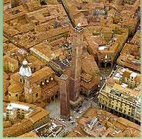About Bologna
Bologna is the capital city of the Emilia Romagna region, in the north of Italy.
Despite having suffered considerable bombing damage in 1944, Bologna's historic centre, Europe's 2nd largest (after Venice), contains a wealth of Medieval, Renaissance, and Baroque artistic monuments of primary importance.
Bologna developed as an Etruscan, then Roman colony along the Via Emilia, the street that still runs straight through the city under the changing names of Strada Maggiore, Rizzoli, Ugo Bassi, and San Felice.
Due to its Roman heritage, the most central streets of Bologna, today largely pedestrianized, follow the grid pattern of the Roman settlement.
Over twenty medieval defensive towers, some of them leaning precariously, remain from the over two hundred that were constructed in the era preceding the security guaranteed by unified civic government.
The most famous ones are the "Two Towers" of Bologna, both built in the XII century. The Asinelli Tower (Torre degli Asinelli) is the highest tower remaining in the city, being 97 metres height. Just beside it, the Garisenda Tower (Torre Garisenda) has been leaning for over six centuries, after
a falldown of the soil under it caused its reduction to the actual size, to prevent the tower fall.
Bologna is home to numerous important churches, the most famous being the basilica of San Petronio, one of the biggest in the World, San Pietro Cathedral,
Santo Stefano basilica and sanctuary, Santa Maria dei Servi basilica, and Beata Vergine di San Luca sanctuary, on Colle della Guardia, one of the hills that sorround the city.
The cityscape is further enriched by elegant and extensive arcades (or porticos), for which the city is famous. In total, there are some 38 kilometres of arcades in the city's historical center (over 45 Km in the cityproper), which make it possible to walk for long distances sheltered from rain, snow, or hot summer sun.
The Sanctuary of the Madonna di San Luca is a very notable site, located just outside the main city on the Colle della Guardia (Guard Hill), and it is the right place to get a panoramic view of the city.
The best way to visit this Sanctuary is by foot as you can walk under the portico mentioned above.
The University of Bologna, founded in 1088, is the oldest existing university in Europe, and was an important centre of European intellectual life during the Middle Ages, attracting scholars from throughout Christendom. A unique heritage of medieval art, exemplified by the illuminated manuscripts and jurists' tombs produced in the city from the thirteenth to the fifteenth century, provide a cultural backdrop to the renown of the medieval institution.
Today, the University's 23 faculties, 68 departments, and 93 libraries are spread across the city and include four subsidiary campuses in nearby Cesena, Forlė, Ravenna, and Rimini.
Bologna is also renowned for its culinary tradition and it is regarded by some as the food capital of Italy. It has given its name to Bolognese sauce, a meat based pasta sauce called in Italy ragų alla bolognese but in the City itself just ragų alone as in Tagliatelle al ragų .
Tagliatelle al ragų, tortellini served in broth and mortadella (the original Bologna sausage) are among the local specialties.
[Thanks to Wikipedia]
Here you can find some useful links to plan your visit to Bologna and Emilia Romagna.
Bologna Official Tourist Information
Wikipedia Guide to Bologna
Bologna Google Map
Emilia Romagna Official Tourist Information
World Guide to Bologna
